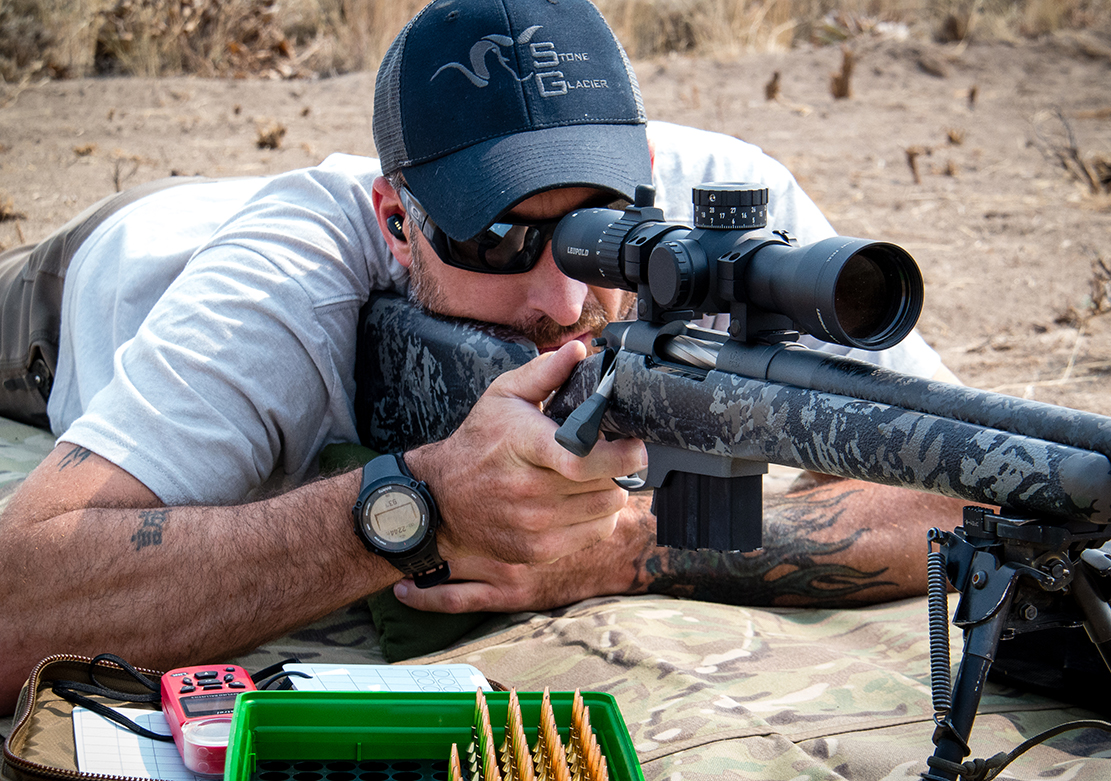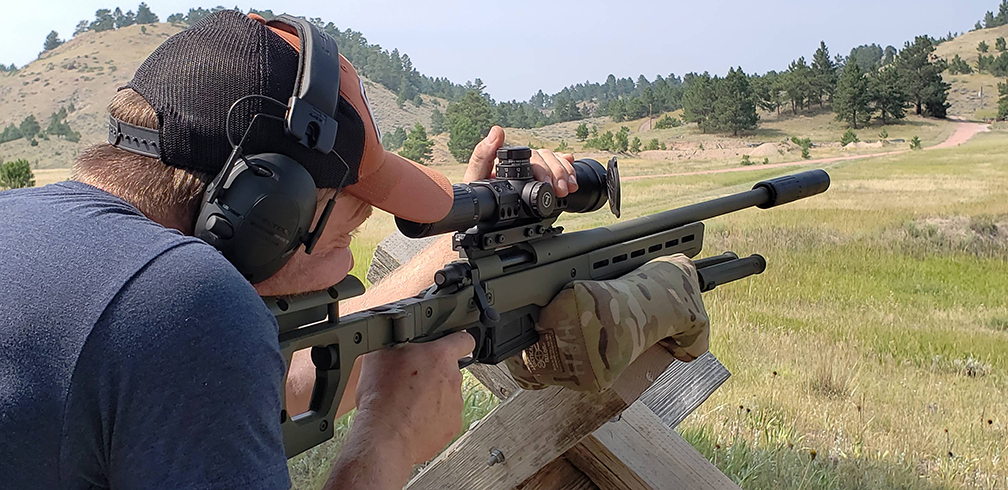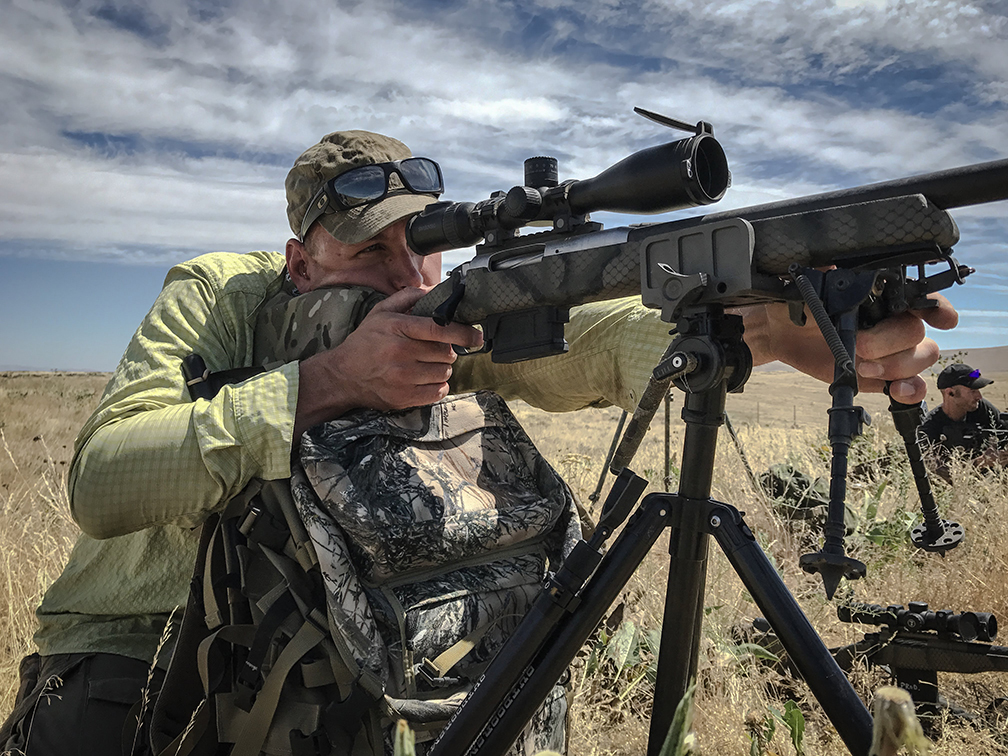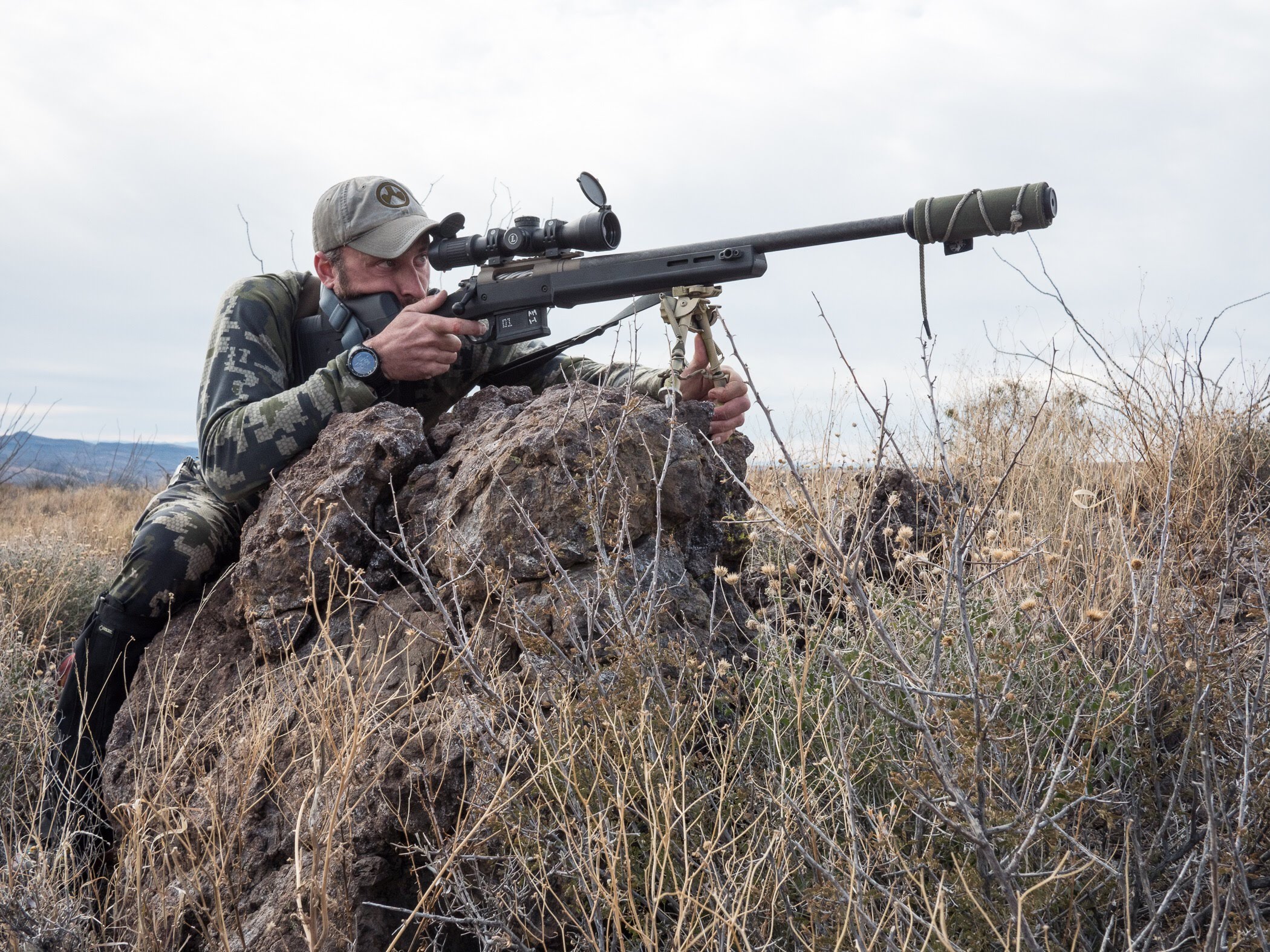If you’ve been shooting long enough, you’ve seen someone get kissed in the forehead by a recoiling rifle scope, or maybe it’s even happened to you. There are a few factors that lead to this unfortunate and totally unnecessary incident. Improper rifle setup and improper eye-relief come to mind immediately. But, in my professional experience, the bigger culprit is almost always improper recoil management, which is a direct result of not learning and applying the fundamentals of marksmanship properly.
Recoil isn’t free guys (and gals), and with lightweight hunting rifles, effective recoil management won’t only prevent you from having an embarrassing and painful experience, it’s also going to help you become a more self-sufficient shooter who doesn’t have to rely on an observer.
What is recoil management? Effective recoil management is using our bodies’ mass and bone structure to absorb the recoil energy of a rifle and transfer that energy throughout the body so that the shooter can easily re-acquire a second sight-picture after the process of recoil and follow-through is complete. More on that second sight-picture shortly. Of course, rifle setup is a very important factor here but plenty of people go about this process in the wrong way. First and foremost, the rifle scope’s eye-relief should be set for the shooter in a “middle-ground” shooting position as I like to think of it. What I mean by that is we can’t set optimal eye relief for just one shooting position if that rifle is meant to be used in a variety of positions.

Setting your eye-relief based on a shooting bench position is a perfect example of what not to do. Sitting at a bench is not representative of what’s really going to happen with your body’s ergonomics in any position other than the bench. Get the eye-relief roughly centered in the prone position first, and then before you torque the top-caps down, get into several different positions, and identify if that eye relief is going to work for you. If you have to sacrifice your body’s square-ness behind the rifle, your scope isn’t set up properly. Granted, you’re going to have to give a little to get a little in certain positions, so you to have to find a happy middle ground for optimal eye-relief. Remember, every shooting position will alter the position of the cheek on the comb of the stock and the idea is to get the setup just right so all you have to do is move your face forward or backwards just a couple millimeters to obtain optimal eye-relief with the rifle still connected to the shoulder. If you have to move your head more than a little fore and aft to maintain your sight-picture, your scope needs to be adjusted.
Now that we’ve got rifle setup done, we can move into unpacking what the forces of recoil are doing and how that will influence your body position, and in turn the rifle’s point of impact on the target. It’s no secret, 90% of hunters out there are shooting cartridges that are far, far too heavy for what they’re doing with them. This isn’t a terminal performance article, but shooting a deer with a .300 RUM at 300 yards is pretty damn silly, and what’s more, you’re making things a lot more difficult on yourself to shoot that huge boomer accurately. The laws of physics apply to everything we do in this universe, and shooting lightweight rifles (especially heavy recoiling magnums) isn’t easy to do because of that. Every tiny little inconsistency in your body position and placement of the rifle’s butt stock in your shoulder pocket is going to drastically influence the rifle’s angle of jump as it goes through the recoil process, which in turn places the bullet’s exit from the muzzle at different points in the vibrational wave pattern of the barrel. Forces and moments folks, it’s a real thing.
Every year about a month before hunting season comes around I see people going to the range with lead-sleds and other crazy rest concoctions to mitigate the recoil of that 6-pound long-action boomer. What they don’t realize is that the point of impact you’re getting from the rifle strapped down and recoiling up against a strap of nylon and sandbagged to a bench is going to be wildly different than what they’re going to see when they shoot that rifle using a shoulder. Guess what, if that rifle is recoiling SO much that you don’t want to shoot it, you’re never going to shoot it well, or consistently.
Now, the meat and potatoes of what we’re trying to get at here is how to effectively manage the recoil of the rifle in funky field shooting positions. More often than not, the moment of truth chooses us, and luck isn’t anything more than an opportunity being presented to the prepared so, you have be prepared to adapt on the fly. With that being said, field shooting positions can be awkward and your body isn’t always going to be perfectly square with your rifle’s line of bore.
The goal in any shooting position is to apply the seven factors common to all shooting positions (see below) and get the body square to the rifle so we can present as much mass as possible behind the rifle to absorb and spread that recoil energy. What this is doing is reducing the amount the rifle is going to move during the recoil process. I can’t stress how important this is in becoming an independent shooter. If, after you fire at your target and you recover from the recoil, your rifle is pointed at something 20-feet to the left of your target there’s no way you’re going to be able to process the vital information the bullet is telling you, especially if you’re solo and don’t have an observer. Besides, an observer should be looked at as an added bonus, only telling you what you already know. After all, whose perspective is going to be the most accurate? Yours, looking at what you just shot at, or theirs sitting a couple feet away?
Another contributing factor to effective recoil management is a proper natural point of aim (NPOA) for that particular shooting position. If you have a solid NPOA, the rifle is going to go through the process of recoil, but it will ALWAYS recover to where the rifle naturally wants to point. It’s all interconnected, and there’s no getting away from applying ALL the fundamentals.
I don’t have many pet-peeves, but without a doubt, improper follow-through is one of them, and follow-through ties into recoil management. How many of you have seen a shooter take a shot at an animal, or a piece of steel for that matter, and instantly take their face off the rifle’s stock and look downrange and ask, “Did I hit it?!”, as if their naked eyes are going to see something more clearly at 500 yards than that 25x rifle scope can. That gets me fired up like nothing else, and in my younger years I always had a roll of duct tape in my range bag to rectify said problem. Now, I don’t do that stuff anymore, but you get my drift; it’s a really bad habit.
Let’s go through the process of the shot, the way it’s supposed to be, starting from the rifle firing:
- Relax, breathe in, breathe out, reticle, apply proper trigger control for that particular shot.
- Rifle recoils, and first sight-picture is lost due to rifle movement.
- Rifle recovers from recoil, and stops moving.
- Shooter acquires second sight-picture and observes bullet impact.
- Shooter processes that information.
- Did the bullet hit? If so, did the bullet have good effects on target? Do I need a follow-up shot?
- If the bullet missed, what is the required correction to get the second shot to hit?
- Did the target move? If so, was it only laterally, or is it now closer or farther? Do I need to make an elevation adjustment to compensate for the new range to target?
- Shooter operates the bolt, chambering a fresh round.
- If necessary, shooter repeats from step 1 for the follow-up shot.
There’s a lot going on there, yes? Could you do all that not looking through your rifle scope? Not a chance. Could you do all that if you got kissed in the forehead? Could you do all that if you didn’t have the rifle stock in firm contact with your shoulder and you’re looking at something 20-feet to the left of the intended target after the rifle recovers from recoil? You are getting my point here I hope. If you didn’t have a competent observer with you, and you missed, the chances of connecting on a second shot are slim to none, all because you couldn’t get the information you needed to make an accurate second-shot correction. Now that we’ve taken a tasty bite out of some humble pie, let’s discuss some tips to help with effective recoil management.
Starting with the basics, having a solid NPOA is going to be a huge help in getting the rifle to recover from recoil and pointed at the intended target. If your body isn’t putting any asymmetric pressures into the rifle for the shot, the rifle is going to want to settle right back where it’s comfortable, thus making your life easier. I don’t like throwing gear at problems that can be mitigated with fundamentals, but installing an effective muzzle brake on your rifle is going to make a huge difference in how much it moves during the recoil process. Directional brake are a big help too because you can tune the direction of the ports to drive the muzzle where you want it for your preference. Another trick I use is manipulating my magnification on the rifle scope. If I know that I’ve got a shaky shooting position and through experience know the rifle is going to move quite a bit under recoil, I’ll widen out my field of view to a point where I’ve got just enough magnification to obtain a precise aiming point and send the shot. By doing this, and having a solid NPOA, I’ve increased my chances of getting the second sight-picture field of view to fall with the target in view so I can process the critical information the bullet is telling me.
There’s a lot more going on with a recoiling rifle than what meets the eye, pun intended. It’s a complex process, and one that the shooter’s input directly impacts. Everything we do as it relates to pressures going into that rifle will affect how it recoils, and where the point of impact is going to fall on the target.
Consistency aside, proper recoil management is going to drastically improve your shooting and your confidence to operate without the need for an observer. I look at an observer as nothing more than a bonus to confirm what I already should know as a shooter. Now, the goal is to get out there and practice these techniques and hold yourself to a higher standard. Put that lead-sled away and shoot your rifle the way you’re going to shoot it in the field. Take an honest look at your setup and if you’re not able to shoot your rifle consistently and spot your own impacts using these tips, it might be time to reevaluate your cartridge choice. Remember, luck is the result of opportunity meeting the prepared. Be prepared, and shoot well.




